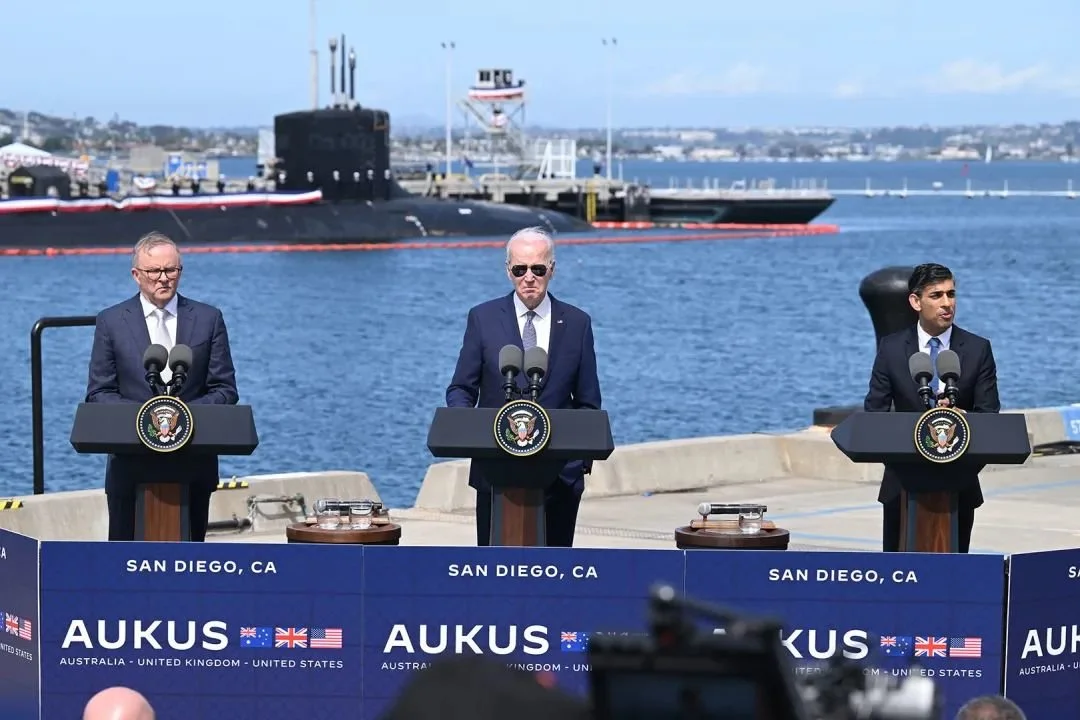AUKUS will define an emerging maritime alliance
U.S. President Joe Biden, British Prime Minister Sunak and Australian Prime Minister Albanese held the Australia-UK-U.S. Tripartite Security Initiative (AUKUS) summit in San Diego, California on March 13. The joint statement announced on the 13th that the partnership between Australia, the United Kingdom and the United States (AUKUS) has identified a path forward for Canberra to acquire conventionally armed nuclear-powered submarines, which is an important moment for the future of the Indo-Pacific region. Below, Brookings scholars assess the impact of the AUKUS partnership on the United States and its allies, China, nuclear nonproliferation, and more.


Bruce Jones
Bruce Jones is currently vice president and director of the Foreign Policy Program at the Brookings Institution, and a senior fellow at the International Order and Strategy Program. He is also an Advisory Professor at the Freeman Spogli Institute of International Studies at Stanford University and Chairman of the Advisory Board of the Center for International Cooperation at New York University.
In September 2021, Australia, the United Kingdom and the United States reached an agreement on nuclear-powered submarine technology and a series of advanced military technologies, which was widely hailed as a “strategic coup” and welcomed by national security experts across the political spectrum. The first two concerns have been allayed: Paris quickly quelled the issue after unwinding cooperation with the French project sparked a diplomatic storm; early proliferation concerns were eased with strong coordination from the International Atomic Energy Agency. Other issues include the impact of the submarine program on the acquisition of nuclear submarines by other allies and the potential for a sharp Chinese response, although a strong response from Beijing may be seen as a sign of success. The deal has already undergone a change of government in Australia and appears to have broad, bipartisan support. More serious operational questions remain: who will build the new submarines, where, in what model, how much will they cost, what will be the impact on the submarine industry base (like most extensive naval shipbuilding bases)? On this point, the chairmen of the Senate Armed Services Committee even expressed their serious concern to the Biden administration in December 2022 that Australia’s acquisition of new submarines would undermine the United States’ own fleet expansion efforts – although they later publicly expressed their support for this effort .
More serious operational questions remain: Who will build the new submarines? Where is the construction site? What model do you use? how much does it cost What will that do for an industrial base for submarines that, like much of the broader naval shipbuilding base, has dwindled since the end of the Cold War? At this point, the heads of the U.S. Senate Armed Services Committee went so far as to express their serious concerns to the Biden administration in December 2022 that Australia’s acquisition of new submarines would undermine the U.S.’s own fleet expansion efforts – although they later publicly expressed their support for this. an effort.
Now, after intensive consultations, the three countries have given a highly credible answer. It will be done in three phases.
Phase one will see: US and UK submarines increase visits to Australian ports; Australian submarine crews embedded in US and UK ships and their shipyards; Australia’s “corresponding” investment in US submarine building infrastructure; US increased funding for this; and the start of significant Australian investment in the people and infrastructure that the project will require in the long term.
Phase two will see the creation of the Western Submarine Rotation Force – a combined force of US and UK submarines operating out of Australian ports. Australia also plans to acquire three to five US-built Virginia-class submarines by the early 2030s.
Meanwhile, Australia and the United Kingdom, with substantial technical assistance from the United States, will begin work on what will eventually become Phase 3 – the joint design and interoperability of a conventionally armed nuclear-powered submarine, designated SSN-AUKUS. The first of these submarines will be built in the UK with an expected delivery date of the late 2030s, before Australia is expected to deliver its own build in the early 2040s.
There are two key factors in this that make it work. First, through a combination of US funding for 2022 ($2.3 billion), new US funding (in the 2023 budget), and Australian investment for a massive initial upgrade at the submarine industrial base. Currently, available funding for U.S. submarine construction exceeds the industrial capacity to build submarines. However, the availability of substantial new funding and long-term, predictable commitment periods should spur industry to expand its capacity to build these boats. Staffing is a slightly trickier issue, but at least the deal will help preserve British expertise; whether Australia can find and train enough staff quickly enough will be a test. Second, because the AUKUS deal is built on a very advanced intelligence-sharing partnership (these three countries are the most active members of the Five Eyes intelligence-sharing group) and involves extensive high-tech A net upgrade of the military industrial and technology base should create compounding effects and political/economic dividends to help sustain this partnership.
To be sure, there are difficult and sensitive issues ahead. Australia’s critics question whether their country is ceding too much sovereignty if what has become their most powerful military tool is deeply embedded in an alliance structure. The Americans have raised concerns about the risks of intelligence sharing and will eventually wonder whether having Britain and Australia embed their own submarine operations would limit America’s freedom of maneuver. But the United States has already resolved such problems within NATO, and Australia has long proved to be the most reliable combat ally of the United States. Neither intelligence sharing nor sovereignty issues appear to be insurmountable.
Wish this could happen sooner. China is working hard to increase the size and quality of its increasingly large navy. Maintaining America’s current generational lead in submarines will require a sprint of its own. Sustaining and expanding America’s own investment in the next generation of Columbia-class ballistic missile submarines—or even in the new “SSN-X” fast attack submarines—is at least as important as AUKUS. AUKUS is more of a marathon, although successfully completing stage two will feel a lot like a sprint. Both are important. In the short term, the technical payoff of advanced collaboration with the UK and Australia, and the benefits of a parallel design with SSN-AUKUS, could accelerate the successful completion of the SSN-X program. We need to increase the long-term capabilities of the Navy, especially submarines.
Even though a major land war in Europe gets most of our attention, the biggest fact in geopolitics is that the world’s two largest powers are separated by 7,000 miles of ocean, and both sides will be competing over it . Responding to China’s growing capabilities in this domain will require new alliance structures that leverage technology and naval capabilities. Together with the new developments in the Group of Four and Japan, AUKUS is an important step in this direction.

Michael E. O’Hanlon
Director of Foreign Policy Studies and Senior Fellow at the Brookings Institution.
As some of the most survivable, lethal, and otherwise useful modern naval capabilities, submarines are closely related to China’s strategic competition in the Indo-Pacific region. The specifics of the AUKUS agreement—most importantly, its promise to increase the overall U.S. and allied submarine building capabilities—give it a net win on these fronts.
If the entire U.S. submarine fleet is included, the initiative would increase the allies’ submarine capabilities by just over 10 percent. But the U.S. fleet is largely focused on operations in the Atlantic and Middle East — with only a handful stationed at the forefront of the Western Pacific. Adjusting for these factors, AUKUS effectively increases the allies’ submarine capabilities by 25%.
AUKUS also makes sense for two other reasons: signal and technology sharing. Canberra, London and Washington are not on the same page on China, and AUKUS will strengthen their strategic cooperation in countering Beijing’s assertive behavior and aggression. At the same time, however, the three countries are likely to moderate each other’s – and especially the US’s – tendency to overly suppress China.
In addition, AUKUS pledged to strengthen technical cooperation by helping to ease export controls and other barriers. At first glance, this may seem like a modest measure, given that both the UK and Australia are established technological powerhouses and close allies of the US. However, many obstacles to close technology sharing remain. AUKUS can help break down these barriers, enabling collaboration on anti-submarine warfare technologies, quantum computing, advanced materials, advanced missiles, directed energy weapons, missile defense, and robotics (among others). The resulting new procedures can also be extended to other allies – as we show the world that despite all the political flaws and occasional dysfunctions of the West, the alliance is still strong.

Ryan Hass
Ryan Horn is currently a senior fellow at the Foreign Policy Program of the Brookings Institution, and is also affiliated with the John L. L. L. Thornton China Center and the East Asia Policy Research Center under the program. Ruien Horn’s main research field is the East Asia policy of the United States, and the specific direction is how to promote the development of the regional foreign policy of the United States to better meet the increasingly urgent political, economic and security challenges it faces in East Asia.
From 2013 to 2017, Ryan Hor served as director of China, Taiwan, and Mongolia affairs at the National Security Council. During his tenure, he provided then-President Obama and senior officials of the White House with comprehensive policy advice on China, Taiwan, and Mongolia, and was responsible for coordinating the implementation of policies by various departments and agencies of the US government in the region. Ruien Horn paid state visits to Beijing and Washington with President Obama’s delegation to China in 2014 and 2015 respectively. In 2016, he attended the G20 Leaders Meeting in Hangzhou, China with the presidential delegation. In the same year, he accompanied the delegation to attend the APEC Leaders Meeting held in Lima, Peru.
The joint declaration of the three countries on the way forward of AUKUS has the potential to greatly enhance the response to emergencies in the Taiwan Strait. The proclamation brought together two asymmetric US advantages in East Asia. The first is its unique undersea combat capability. The second is America’s network of security alliances and partnerships.
The announcement of AUKUS builds on several recent transformational events in the region. These events include Japan’s generational escalation of its defense posture, the Philippines’ decision to provide additional base access for U.S. forces, U.S. progress in decentralizing its power projection capabilities, and improving relations between Japan and South Korea. A breakthrough in the latter should unleash more trilateral defense and intelligence coordination between the US, Japan and South Korea.
These developments have brought new challenges to the Taiwan Strait issue. Especially given the lead time required to deploy the full capabilities of AUKUS, the United States and its partners maximize defensive readiness while minimizing direct provocation, acknowledging that tensions between these two imperatives can sometimes arise. Managing such tensions will require statesmanship and foresight.

Amy J. Nelson
Amy J. Nelson is a Foreign Policy Fellow at the Center for Security, Strategy, and Technology at the Brookings Institution. She conducts research and advises on defense innovation, arms control and non-proliferation. Her work focuses on the role of emerging technologies in all three. Most recently, she was a researcher at the Center for Weapons of Mass Destruction Research at the National Defense University. She is a research affiliate at the Center for International and Security Studies at the University of Maryland and teaches in the Defense and Strategic Studies Program at Missouri State University. She was previously a Bosch resident fellow at the German Council on Foreign Relations in Berlin, Germany, where her research focused on European defense innovation and transatlantic relations. Nelson was a Stanton Fellow at the Council on Foreign Relations and a policy analyst in the State Department’s Bureau of Political-Military Affairs.
The United States has invoked the Nuclear Non-Proliferation Treaty (NPT) in its recent AUKUS statement, presenting AUKUS as a sign that the nuclear deal — and the grand deal it contains — is still alive.
The AUKUS partnership described access to US nuclear submarine technology as a reward for Australia’s good non-proliferation record, a nod to the NPT’s commitment to provide nuclear technology to non-nuclear-weapon states in exchange for them not pursuing nuclear weapons. The move is unprecedented in this day and age. The last time the United States shared nuclear submarine technology was with ally Britain in the 1950s. Washington now describes AUKUS as establishing a new “nuclear governance” among allies, a term that once referred to the safety and security of a country’s nuclear stockpile.
The NPT, signed in 1968, was originally intended to prevent more countries from obtaining the highly enriched uranium needed to pursue nuclear weapons programs and in this way limit/contain nuclear proliferation. While the Australian Navy currently operates six diesel-electric submarines, the newer Virginia-class attack submarines (and eventually the AUKUS-class submarines) being sold to Australia are clearly the next generation. They can stay submerged longer and can travel farther than conventional submarines before surfacing.
Controversial—if not immediate—transfers of fissile material and nuclear technology from a nuclear-weapon state to a non-weapon state are ostensibly non-military uses permitted by the NPT. Although China begs to differ; Beijing has said that AUKUS is a clear violation of the NPT. Other countries, such as Brazil and India, disagree, though. All of this means that the recently announced AUKUS agreement is either a reinterpretation of the NPT and access to new-age nuclear technology, or a fundamental violation of the aging arms control infrastructure. While there is no clear violation of the agreement, whether the transfer was actually for “peaceful purposes” will certainly be questioned. The whole AUKUS program is aimed at China.

tom stefanik
(Tom Stefanick)
Military and intelligence technology expert, visiting researcher at the Brookings Institution, an American think tank
With the new agreement to implement the AUKUS deal, the Australian government will be procuring one of the most nimble and capable war machines ever built. During the last decade of the Cold War, the primary mission of U.S. attack submarines was to threaten Soviet strategic missile submarines in their home waters. Great powers are concerned about the survivability of their sea-based nuclear deterrents. For example, the U.S. Navy has made building its new strategic submarine a top priority and is making improvements to ensure that this nuclear deterrent is never threatened.
In the 1980s, the United States engaged in a lively public debate about the benefits of threatening Soviet ballistic missile submarines. Australia should engage in a similar public discussion, as their attack submarines and crews may one day operate in the same waters as enemy strategic weapons.
Indeed, the US will need to demonstrate the economic, military and strategic value of a stronger relationship with Australia under AUKUS if the decades-long project is to succeed in the long term. If the Australian people can see the real benefits of greater engagement with the US, and understand the return on their investment in submarines, they will be able to support AUKUS for the long term, after all these naval ships are designed to never be seen. AUKUS would be seen as a net economic gain for Australia if the US could share the broadest technical expertise outside of dedicated shipbuilding.

Constance Terzenmüller
(Constanze Stelzenmüller)
Director and Senior Fellow, Center for America and Europe, Brookings Institution
At AUKUS Day in London, the UK also unveiled a somewhat puzzling document titled “Comprehensive Review Update 2023”. It provides important and revealing strategic context for the announcement of the Submarine Alliance, highlighting the rise of a “new ‘Atlantic-Pacific’ network of partnerships based on the critical importance of Euro-Atlantic and Indo-Pacific prosperity and security.” Inseparable” common view. This framework reflects the realities of a highly globalized European middle power.
This is exactly in line with much of the rest of Europe’s thinking – indeed, the EU in its own new EU Maritime Strategy (itself an update to a 2014 document) calls on its member states to “expand their presence and operations in the Indo-Pacific” , as a means of supporting their mutual security and prosperity.
The UK’s new strategy document is also notable for its emphasis on the risks of escalation in global strategic competition. In a strikingly dark passage, it warns of “systemic competition … above and below the threshold of armed conflict – competition for the balance of military, economic and political power”. It singles out China as a “systemic challenge that defines the era…in almost every aspect of national life and government policy”. In other words, the UK is preparing for a future of permanent global friction generated by interdependence and competition (and possibly armed conflict).
This is not a challenge for a medium-sized country that, whatever its prospects, can survive alone; therefore, it emphasizes alliances like AUKUS and strong friends like the US and Australia. Interestingly, however, the UK’s new document makes up for the omissions of the previous document by broadly emphasizing its “valuable close cooperation” with its European counterparts – and even with the EU.

Katrin Talmadge
(Catlin Talmadge)
Associate Professor of Strategic Security Studies at the School of Foreign Service at Georgetown University, Nonresident Senior Fellow in Foreign Policy at the Brookings Institution, and Fellow of the Strategic Security Studies Program at the Massachusetts Institute of Technology.
Recent announcements have fleshed out AUKUS, providing more detail on how Australia, the US and the UK will actually implement this important agreement. It deepens the political commitment of the three countries to cooperate on undersea warfare, an important area of future competition with China. Simply put, submarines are likely to be one of the only survivable platforms in the Western Pacific for years to come, so building greater undersea capabilities from U.S. allies is welcome. In the short term, the agreement will give the US and UK greater access to Australia’s strategic ports. In the long run, the agreement aims to build or strengthen the nuclear submarine industrial base of all three countries, with the ultimate goal of putting more conventionally armed attack submarines at sea.
The agreement is not without risks: intelligence risks related to sharing extremely sensitive U.S. technology; political risks related to whether the governments of all three countries will maintain cooperation through the agreement’s envisaged lifetime into the 2040s; and the very complex design of new submarines associated technical risks; and operational risks as Australia joins the naval nuclear propulsion club. Taken together, the Biden administration’s phased approach is sensible, and its goals are laudable. We’ve also learned in recent months that AUKUS has thus far received the blessing of the IAEA, which should help mitigate potential non-proliferation concerns raised when the deal was first announced.

Andrew Yeo
Senior Fellow on North Korea at the Brookings Institution
This week’s AUKUS joint statement could reignite discussions in Seoul about South Korea’s own lack of nuclear submarines. The AUKUS deal, which has so far raised no major concerns from the IAEA, would allow Australia to proceed with the purchase of up to five US nuclear-powered submarines. While South Korea is interested in acquiring nuclear submarines to counter North Korea’s growing nuclear threat, it has not yet received a commitment from Washington to transfer a similar nuclear-powered capability. Under the current nuclear arrangement with the United States, South Korea is prohibited from processing the enriched uranium needed to power its own nuclear submarines. Although President Donald Trump suggested in 2017 that South Koreans buy American nuclear submarines, the United States has not made progress due to proliferation concerns, according to reports. Other experts have also suggested that non-nuclear submarines are adequate for the South Korean fleet and are better suited for missions in the Yellow, East and East Seas.
As the AUKUS agreement moves into its next phase, some proponents of nuclear submarines may point to a double standard in the agreement regarding sharing nuclear submarine technology and capabilities with some allies and not with others. While the current South Korean government has not raised such an issue, nuclear submarines could become a point of contention in the future with the main opposition Democratic Party, which typically seeks greater alliance autonomy. The Republic of Korea Navy, which introduced a formal submarine command at Jinhae Naval Base in 2015, may also be keen to supplement its 19 mostly diesel-electric submarines with nuclear submarines. There is no one-size-fits-all approach to league management. However, a Biden administration will need to be prepared to explain why specific capabilities and nuclear arrangements are shared with some allies and not others, even when decisions are made with sound strategic guidance.
Source: Phoenix New









